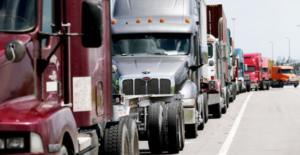Parking trucks
From MG+M The Law Firm. The lack of availability for truck parking has been a top concern for carrier, drivers, and other stakeholders for the past several years. Truckers are often cited for parking on shoulders, ramps, and other non-designated areas when there is no parking availability. Alternatively, the industry is seeing drivers parking their…

From MG+M The Law Firm.
The lack of availability for truck parking has been a top concern for carrier, drivers, and other stakeholders for the past several years. Truckers are often cited for parking on shoulders, ramps, and other non-designated areas when there is no parking availability. Alternatively, the industry is seeing drivers parking their rigs prior to reaching the maximum hours-of-service when a spot is found. Lost wages for early parking “averages over $4,600 annually per driver.” Congress attempted to address this when it passed Jason’s Law, which made it a federal priority to address the parking problem. However, Jason’s Law has not led to any significant, demonstrative results. States have taken it upon themselves to attempt to alleviate this hardship in a number of way. Two of which includes two broadly defined technological systems.
The first group of technologies is referred to as “sensing.” This system monitors when trucks are filling spaces or facilities. It is further divide into two subdivisions, direct and indirect. Direct sensing monitors the spaces themselves, by for instance, placing hardware in the pavement to detect if a spot is occupied or by using cameras and software to count available spots. Indirect sensing, on the other hand, monitors the entrances and exits of facilities usually through cameras or magnetic trip wires. Direct sensing methods, however, are considered more accurate and have become the preferred method.
The second classification of technologies is dissemination. Dissemination technology essentially gathers parking data and conveys it to interested parties. The mechanisms to communicate the information varies from in-cab systems to smart phone apps or GPS networks.
These technologies are extremely beneficial and may go a long way in helping drivers find appropriate safe parking at the right times. However, with these technologies come new concerns, primarily driver distraction. Specifically, smart phone applications can be problematic as most states prohibit operating a motor vehicle while using a phone. Additionally, push notifications through in-cab systems can be equally as distracting. An alternative to help remedy the distraction of on-board systems is variable messages signs. A majority of long haul drivers found the signs “helpful and accurate” where they were present.
Technology can go a long way in addressing a constant and pressing concern of drivers and carriers. However, with technology comes new dangers and concerns. Finding a way to balance the safety of the driver and those sharing the road with them, and the need for accurate and available information is the first critical step needed to fully address the overall problem of parking. These discussed technologies have begun to chip away, but more work needs to be done and further improvements are anticipated over the next few years.
